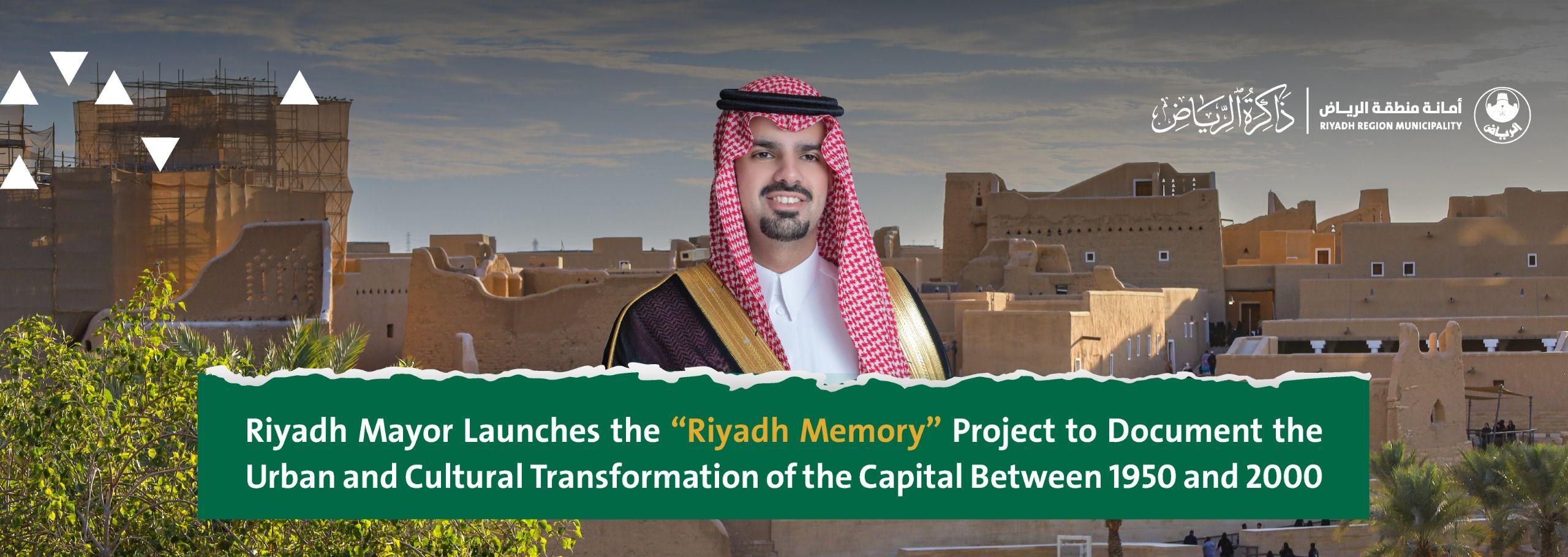Source: Riyadh Region Municipality
2025-11-12His Highness Prince Dr. Faisal bin Ayyaf, Mayor of Riyadh Region, has launched the “Riyadh Memory” project — a comprehensive and pioneering initiative that documents the architecture and urban landmarks that shaped the identity of the capital during the second half of the twentieth century. The project highlights the city’s social and urban development stages, supporting the municipality’s efforts to preserve architectural heritage and enhance the cultural identity of Riyadh.
The project aims to document and preserve the urban memory of Riyadh through a rigorous scientific methodology that integrates field surveys, historical and social studies, and architectural analysis. This approach helps build a comprehensive knowledge base on the evolution of the city’s urban fabric over fifty years of transformation.
The project carried out an extensive field survey covering 112 residential neighborhoods and 1,155 sites, including more than 1,000 buildings of various types: governmental, service, residential, and socially and historically significant structures. Among these were 100 buildings classified as “Riyadh Memory Buildings,” 55 buildings of historical and social significance, 70 abandoned buildings, 35 buildings that were later demolished, and 70 designs of buildings that were never executed. The project also developed detailed analytical and assessment forms evaluating each building’s structural, architectural, and historical aspects, and created digital identification cards (Building IDs) containing data, images, and comprehensive descriptions for each building.
The project documented the historical and social significance of selected buildings through extensive studies that examined notable architectural models such as the Red Palace, Riyadh Water Tower, Prince Faisal bin Fahd Stadium, and the Khazzan Residential and Commercial Center, among other landmarks tied to the collective memory of Riyadh’s residents.
As part of its technical efforts, the project produced detailed 2D and 3D redrawings of more than 150 buildings to accurately document their architectural and design elements and present them in models and exhibitions organized by the municipality. In addition, distinctive identification plaques were designed for the surveyed buildings.
The project also produced five documentary films covering the historical phases from the 1950s to the 1990s, along with a main 75-minute documentary titled “Riyadh Memory”, capturing the city’s urban transformation journey with contributions from a group of Saudi and Arab academics and architects.
Academically, the project published two peer-reviewed research papers in international journals — one outlining the methodology for documenting modern architectural heritage, and the other analyzing architectural transformations in Riyadh during the 1950s.
Among the project’s outputs is the publication of the “Riyadh Memory” book, which combines historical narrative and architectural analysis, supported by rare photographs of major buildings and landmarks in the capital. The book also features historical scenes of the Custodian of the Two Holy Mosques, King Salman bin Abdulaziz — may God preserve him — during his tenure as Governor of Riyadh, documenting his pioneering role in the city’s urban renaissance.
The municipality has also launched the official website for the Riyadh Memory project, enabling visitors to explore the city’s architectural landmarks from 1950 to 2000 through rich, interactive content featuring images, data, and historical background. The platform invites residents to share their personal memories associated with historic buildings, thus preserving the human and social dimension of Riyadh’s architecture.
To ensure long-term sustainability, the municipality is developing interactive exhibitions, a heritage store offering project-related products, and educational workshops and programs to raise public awareness of the importance of architectural heritage. The project also participates in national and cultural events such as the Riyadh International Book Fair, architectural symposiums, and local and international conferences to strengthen its role as a cultural and knowledge resource for the city.
The “Riyadh Memory” project builds on the efforts of the Riyadh Municipality to achieve sustainable urban development that enhances quality of life by preserving the architectural and cultural heritage and integrating it into modern urban planning in line with Saudi Vision 2030. It reflects the municipality’s mission to advance Riyadh through sustainable urban development, high-quality services, and effective partnerships toward a vibrant and thriving community.
Featured topics
Comments and Suggestions
For inquiries or comments regarding municipal services, please fill in the required information.
Your Comment
Comments
No comments have been added yet
Your Rating
Last Update:
11/12/2025
Was the content helpful?
2 visitors liked the page content out of 2 shares
